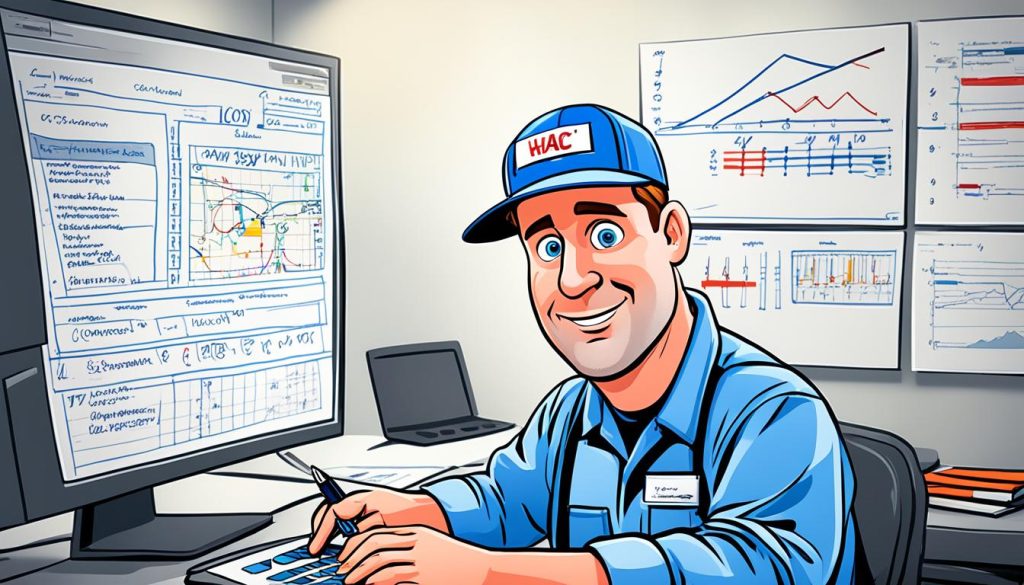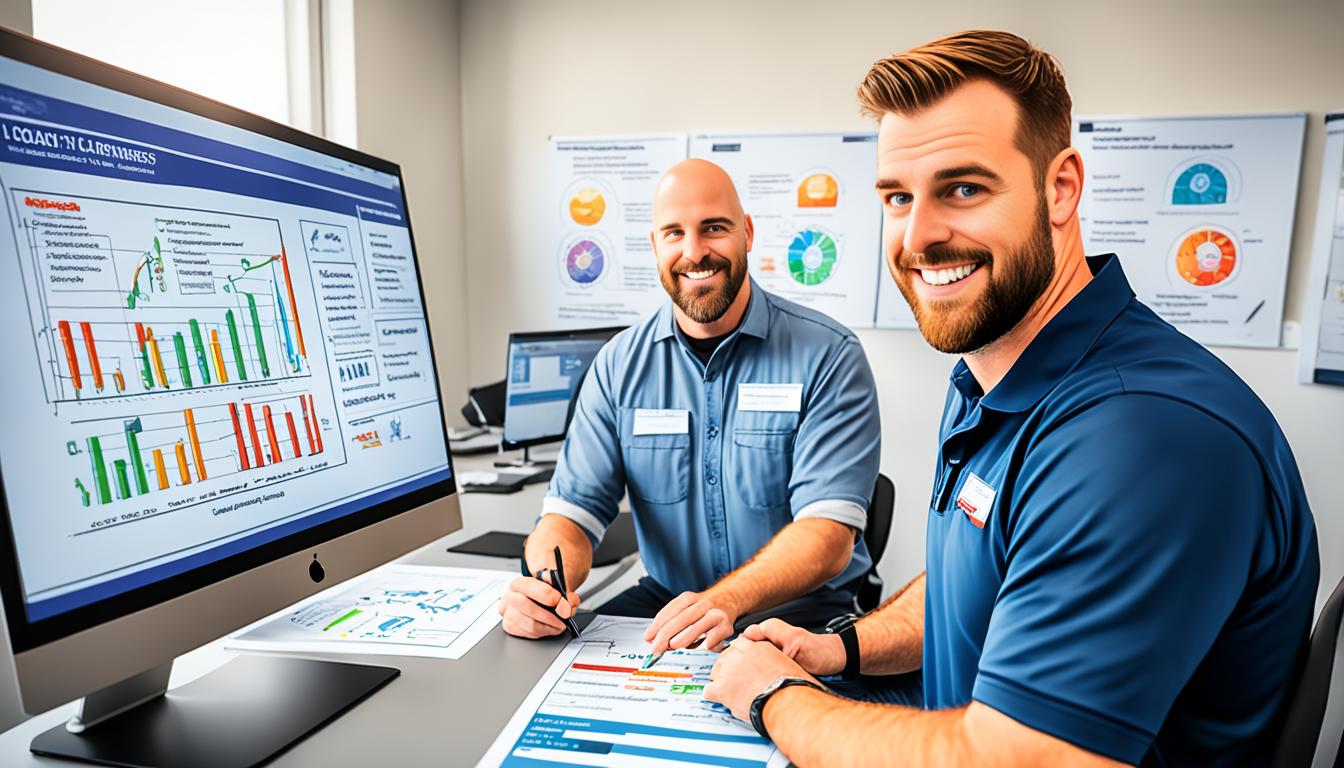To train HVAC technicians well, mix theory with practical skills. Start with self-study using Manual J and practice on different buildings. This method deepens their understanding of building science and gets them ready for more advanced training.
First, stress the value of manual calculations before moving to computer programs. This stops just memorizing and builds a strong base in heat load analysis. Think about signing technicians up for community college courses on HVAC systems design for more formal learning.
Next, bring in energy modeling tools and building performance simulation software. These are key for modern HVAC training. They help technicians fully grasp heat load calculations in real situations.
This structured way will give your HVAC technicians the skills they need to shine in heat load analysis and system design. It makes sure they’re ready for the industry’s challenges.
Understanding the Importance of Heat Load Calculation in HVAC
Heat load calculation is key to HVAC design. It helps figure out how much heating and cooling a space needs. This ensures the space stays comfortable and uses energy wisely. It’s vital for both home and business HVAC setups.
Definition and Purpose of Heat Load Calculation
Heat load calculation estimates the heating or cooling needed for a space. It looks at building size, insulation, how many people use it, and the local weather. Getting this right helps pick the right HVAC size, preventing problems that waste energy and make people uncomfortable.
Impact on HVAC System Design and Efficiency
Getting the heat load right changes how well an HVAC system works. It helps in:
- Selecting the right size equipment
- Designing effective duct systems
- Optimizing airflow for comfort and energy savings
- Determining appropriate grille and register placement
This way, HVAC systems keep temperatures steady, use less energy, and improve air quality indoors.
Regulatory Requirements and Industry Standards
The HVAC field has its own rules for calculating loads. These standards make sure designs are reliable and consistent. Important groups and standards include:
| Organization | Standard | Application |
|---|---|---|
| ACCA | Manual J | Residential load calculations |
| ASHRAE | Standard 183 | Commercial load calculations |
| IECC | Energy Code | Building energy efficiency requirements |
Following these standards means you’re doing things right in HVAC design and setup. Knowing how to calculate heat load helps you make systems that are efficient, comfy, and meet the rules for homes and businesses.
Selecting the Right Heat Load Calculation Software
Choosing the right heat load calculation software is key for your HVAC design work. You should look for tools that work well with ACCA manuals. They should also be good for both home and business projects. Let’s see how to pick the best software for you.
When checking out Energy Modeling Tools, find ones with psychrometric charts, load forms, and duct sizing. These tools make your work easier and more precise.
It’s vital to follow industry standards. Make sure the software meets all the rules and fits with HVAC Certification Programs. This keeps you up-to-date with the latest in the field.
Key Features to Consider
- Integration with ACCA manuals (J, D, S, and T)
- Support for residential and commercial projects
- Psychrometric charts and load estimating forms
- Duct sizing capabilities
- Compliance with industry standards
Building Performance Simulation is also important. Choose software that lets you model energy efficiency and system performance well.
| Software Feature | Importance |
|---|---|
| ACCA Manual Integration | High |
| User-Friendly Interface | Medium |
| Customization Options | Medium |
| Regular Updates | High |
| Technical Support | High |
By looking at these factors, you can pick heat load calculation software that improves your HVAC design work. It will give you accurate and efficient results.
Fundamentals of Manual J and Other ACCA Manuals
The Air Conditioning Contractors of America (ACCA) manuals are key for HVAC Design Fundamentals. They help with Load Calculation Methods in Residential HVAC Systems. Let’s look at the main manuals and their roles in HVAC design.
Overview of Manual J, D, S, and T
Manual J is vital for figuring out a building’s heating and cooling needs. Manual D deals with duct design for good airflow. Manual S helps pick the right equipment, and Manual T covers how air spreads in the system. These manuals work together for a full HVAC system design.
| Manual | Purpose | Key Function |
|---|---|---|
| J | Load Calculation | Determines heating and cooling requirements |
| D | Duct Design | Ensures proper airflow throughout the system |
| S | Equipment Selection | Guides choosing the right HVAC units |
| T | Air Distribution | Covers proper air delivery in rooms |
Integrating Manual Calculations with Software Tools
Software tools make designing easier, but knowing manual calculations is key. This knowledge lets you check software results and make smart choices. Mixing manual skills with software makes HVAC designs better and more precise.
Benefits of Understanding Manual Processes
Knowing manual calculations has many benefits. It deepens your HVAC knowledge, boosts troubleshooting skills, and lets you tailor designs for special cases. This is very useful for complex projects or adjusting to local climate changes in Residential HVAC Systems.
Developing a Comprehensive Training Curriculum
A well-structured HVAC training curriculum is key for technicians to learn heat load calculation skills. It should include important parts of HVAC systems, from basics to advanced commercial uses.
Begin with basic concepts like analyzing weather data, understanding R-values and U-values. These are crucial for grasping how heat moves in buildings. Then, introduce heat transfer multipliers (HTM) to show how materials impact energy flow.

Use practical exercises with tools like the Trane Ductulator™ and psychrometric charts. These activities make the theory more concrete and prepare technicians for real situations.
Make sure HVAC certification programs cover both home and business HVAC designs. For businesses, focus on complex systems like those in restaurants. Include topics on energy recovery ventilators (ERV) and economizers to talk about saving energy.
| Curriculum Component | Residential Focus | Commercial Focus |
|---|---|---|
| Load Calculations | Manual J | ASHRAE Methods |
| Equipment Selection | Split Systems | Rooftop Units |
| Duct Design | Manual D | Complex Zoning |
| Air Distribution | Residential Comfort | IAQ for Businesses |
This diverse curriculum prepares technicians for both home and business projects. It ensures they can handle heat load calculations in different situations.
Train Technicians on Heat Load Calculation Software
Training HVAC technicians on heat load calculation software is key for efficient system design. It includes hands-on experience with energy modeling tools and building performance simulation software. Let’s look at the main parts of this training.
Step-by-Step Software Navigation Training
Begin by showing technicians the Heat Load Analysis Software’s user interface. Walk them through menus, toolbars, and how to navigate. Practice making new projects, saving files, and finding help in the software.
Data Input Best Practices
Teach technicians to enter accurate building data into Energy Modeling Tools. This includes:
- Entering building dimensions and orientation
- Specifying construction materials and insulation values
- Defining HVAC system components
- Inputting occupancy schedules and internal loads
Stress the need for precise data entry for trustworthy Building Performance Simulation results.
Interpreting Software Results Accurately
Train technicians to understand the output from Heat Load Analysis Software. Focus on key metrics such as:
- Sensible and latent heat loads
- Sensible heat ratio (SHR)
- Peak load conditions
- Energy consumption estimates
Encourage critical thinking when reviewing results. Teach technicians to look for any odd values or errors in the input data or calculations.
Hands-On Training Techniques and Exercises
HVAC training programs shine when they focus on hands-on exercises. These practical sessions help technicians get better at load calculations for home HVAC systems. Let’s look at some effective ways to boost your training.

Begin by using real building plans in your workshops. This gives trainees a feel of the real projects they’ll see in their jobs. Have them do manual calculations first, then use software tools. This helps them understand the basics better and improves their grasp of the process.
Then, introduce tools like the Trane Ductulator™ for duct sizing exercises. This hands-on activity is crucial for technicians learning to design efficient HVAC systems. Make sure to include psychrometric chart readings in your training. This helps technicians understand how air properties work together.
Encourage trainees to practice on their own homes or their relatives’ houses. This real-world practice makes their skills stronger and builds their confidence. It also lets them apply load calculation methods in different home settings.
| Exercise Type | Benefits | Tools Used |
|---|---|---|
| Manual Calculations | Reinforces fundamental concepts | Building plans, calculators |
| Duct Sizing | Improves system design skills | Trane Ductulator™ |
| Psychrometric Chart Reading | Enhances understanding of air properties | Psychrometric charts |
| Real Home Practice | Provides real-world experience | Residential HVAC systems |
By using these hands-on methods, you’ll make a strong HVAC training program. It will prepare technicians for the challenges of load calculation in various home settings.
Incorporating Real-World Scenarios in Training
Real-world scenarios are key in training HVAC technicians. They connect theory with practice, getting technicians ready for real-world challenges. Let’s see how to add these scenarios to your training.
Case Studies: Residential and Commercial Projects
Case studies are great for learning HVAC Design Fundamentals. For homes, look at single-family houses and apartments. For commercial projects, consider offices, restaurants, and shops. Each type brings its own set of challenges in figuring out loads and designing systems.
| Project Type | Key Considerations | Challenges |
|---|---|---|
| Single-Family Home | Room-by-room load calculation | Varying occupancy patterns |
| Office Building | Zoning for different areas | High heat loads from equipment |
| Restaurant | Kitchen ventilation needs | Fluctuating occupancy levels |
Troubleshooting Common Calculation Errors
Tools for Building Performance Simulation can spot and fix common errors. Train technicians to catch mistakes like wrong building orientation or missing heat sources. Present scenarios with errors for them to solve.
Adapting to Regional Climate Variations
HVAC systems need to fit the local climate. Teach technicians how to adjust for different areas. This could mean handling high humidity near the coast or extreme temperatures in deserts. Use climate data to mimic real conditions in your training.
Adding these real-world scenarios will prepare your technicians to handle various HVAC challenges with confidence.
Utilizing Online Resources and Continuing Education
In the fast-paced world of HVAC, staying updated is key. You can boost your skills through online HVAC training programs and certification courses. The Air Conditioning Contractors of America (ACCA) offers a valuable 6-hour video series on commercial HVAC design basics. This is perfect for enhancing your knowledge.
Pursuing continuing education credits is a smart move for HVAC technicians. Organizations like North American Technician Excellence (NATE), International Code Council (ICC), ESCO Group, and Refrigeration Service Engineers Society (RSES) provide excellent opportunities. These programs keep you at the forefront of industry standards and best practices.
Access to online resources is key for ongoing learning. ACCA manuals, technical guides, and industry publications offer in-depth knowledge on heat load calculation and HVAC design. Energy modeling tools are becoming increasingly important in the field. Familiarizing yourself with these can give you a competitive edge.
Webinars and virtual workshops are great ways to stay current with the latest trends in HVAC technology. These online sessions often feature industry experts sharing insights on advanced energy modeling tools and innovative HVAC design techniques. By actively participating in these learning opportunities, you’ll continually improve your skills and maintain your edge in the HVAC industry.





0 Comments